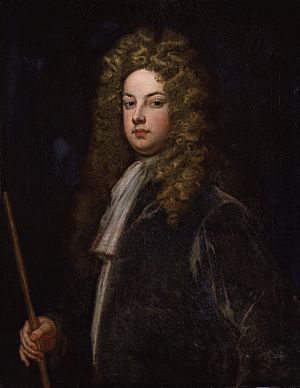Charles Howard, 3rd Earl of Carlisle facts for kids
Quick facts for kids
The Earl of Carlisle
|
|
|---|---|

Portrait by Godfrey Kneller
|
|
| Chief Minister of Great Britain First Lord of the Treasury |
|
| In office 23 May 1715 – 10 October 1715 |
|
| Monarch | George I |
| Preceded by | The Earl of Halifax |
| Succeeded by | Robert Walpole |
| In office 30 December 1701 – 8 May 1702 |
|
| Monarch | Anne |
| Preceded by | The Earl of Godolphin |
| Succeeded by | The Duke of Marlborough |
| Member of Parliament for Morpeth |
|
| In office 1689–1692 Serving with Roger Fenwick
|
|
| Monarch | William III and Mary II |
| Preceded by | Sir Henry Pickering |
| Succeeded by | George Nicholas |
| Personal details | |
| Born |
Charles Howard
1669 |
| Died | 1 May 1738 Bath, Somerset Kingdom of England |
| Spouse | Lady Anne de Vere Capell |
| Children | 6 |
| Parents | Edward Howard, 2nd Earl of Carlisle Elizabeth Uvedale |
Charles Howard, 3rd Earl of Carlisle (around 1669 – May 1, 1738) was an important British nobleman and politician. He held many key roles in the government during his lifetime.
Charles Howard was the oldest son of Edward Howard, 2nd Earl of Carlisle. He became the Earl of Carlisle when his father passed away in 1692. In 1683, he married Lady Anne de Vere Capell. She was the daughter of Arthur Capell, 1st Earl of Essex.
Charles Howard's Political Life
Charles Howard began his political career in 1689. He was chosen as a Member of Parliament (MP) for Morpeth. An MP is someone elected to represent their local area in the country's parliament. He also had a home in Soho Square in London.
He held several important jobs:
- From 1693 to 1728, he was the Governor of Carlisle.
- From 1694 to 1714, he was the Lord-Lieutenant of Cumberland and Westmorland. A Lord-Lieutenant is the King or Queen's personal representative in a county.
- Between 1700 and 1702, King William III made him a Gentleman of the Bedchamber. This was an important role in the royal household.
- He served as First Lord of the Treasury from 1701 to 1702. This role was similar to being in charge of the country's money.
- In 1701, he became a Privy Counsellor. This meant he was a trusted advisor to the monarch.
- He also acted as Earl Marshal from 1701 to 1706. He took on this duty because his cousin, the Duke of Norfolk, was too young for the role.
When Anne, Queen of Great Britain died in 1714, Charles Howard was appointed a Lord Justice of the Realm. This meant he helped govern the country until King George I of Great Britain arrived. King George I then reappointed him as First Lord of the Treasury from May 1715 to October 1715. He was also made Constable of the Tower of London from 1715 to 1722.
Business Ventures
From 1699 to 1709, Charles Howard was involved in some business ventures with a man named John Breholt.
- First, Charles Howard supported a plan to find treasure from a sunken ship near Havana. Breholt even named his ship Carlisle, but the plan didn't work out.
- A few years later, Charles Howard supported another plan. This plan was presented directly to Queen Anne. It aimed to bring back people who had left England and were living in Madagascar, along with any wealth they had gathered. However, this plan also didn't work out when more information about Breholt became known.
His Family and Home
In 1699, Charles Howard started building a grand new home called Castle Howard in Yorkshire, England. He hired the famous architect Sir John Vanbrugh to design it. This beautiful Baroque mansion is still lived in by his family today.
Charles Howard passed away in Bath in 1738. He is buried in the family mausoleum at Castle Howard. He had six children:
- Henry Howard, 4th Earl of Carlisle (1693–1758)
- General Sir Charles Howard (around 1696–1765)
- Lady Harriet Howard, who died young
- Lady Elizabeth Anne Howard, who married twice
- Lady Anne Howard, who also married twice
- Lady Mary Howard, who never married
Images for kids


